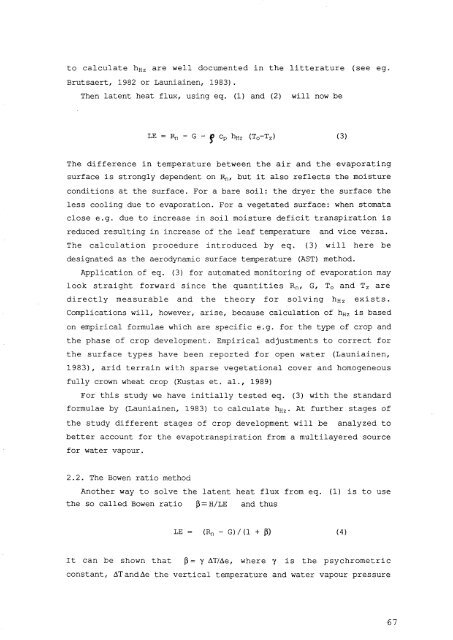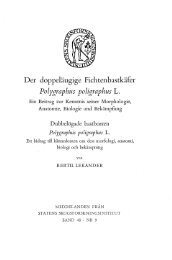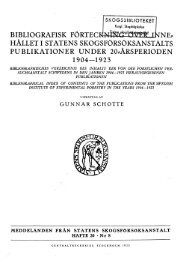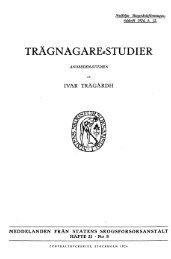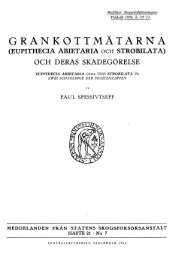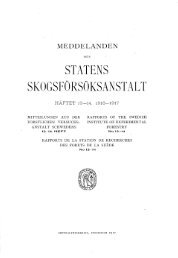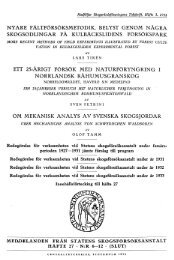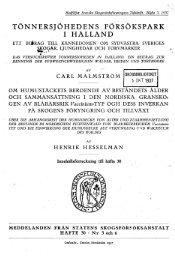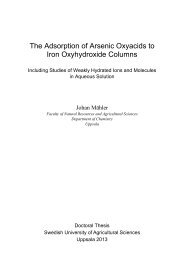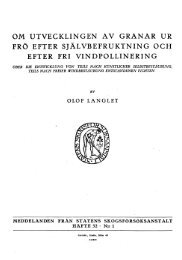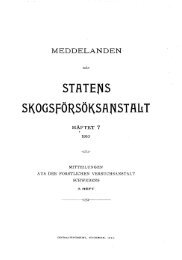SVERIGES LANTBRUKSUNIVERSITET - Epsilon Open Archive - SLU
SVERIGES LANTBRUKSUNIVERSITET - Epsilon Open Archive - SLU
SVERIGES LANTBRUKSUNIVERSITET - Epsilon Open Archive - SLU
You also want an ePaper? Increase the reach of your titles
YUMPU automatically turns print PDFs into web optimized ePapers that Google loves.
to calculate h Hz are well documented in the litterature (see ego<br />
Brutsaert, 1982 or Launiainen, 1983).<br />
Then latent heat flux, using eq. (1) and (2) will now be<br />
LE (3)<br />
The difference in temperature between the air and the evaporating<br />
surface is strongly dependent on R n , but it also reflects the moisture<br />
conditions at the surface. For a bare soil: the dryer the surface the<br />
less cooling due to evaporation. For avegetated surface: when stomata<br />
close e.g. due to increase in soil moisture deficit transpiration is<br />
reduced resulting in increase of the leaf temperature and vice versa.<br />
The calculation procedure introduced by eq. (3) will here be<br />
designated as the aerodynamic surface temperature (AST) method.<br />
Application of eq. (3) for automated monitoring of evaporation may<br />
look straight forward since the quantities Rn , G, To and Tz are<br />
directly measurable and the theory for sol ving h Hz<br />
exists.<br />
Complications will, however, arise, because calculation of h Hz is based<br />
on empirical formulae which are specific e.g. for the type of crop and<br />
the phase of crop development. Empirical adjustments to correct for<br />
the surface types have been reported for open water (Launiainen,<br />
1983), arid terrain with sparse vegetational cover and homogeneous<br />
fully crown wheat crop (Kustas et. al., 1989)<br />
For this study we have initially tested eq. (3) with the standard<br />
formulae by (Launiainen, 1983) to calculate h Hz ' At further stages of<br />
the study different stages of crop development will be analyzed to<br />
better account for the evapotranspiration from a multilayered source<br />
for water vapour.<br />
2.2. The Bowen ratio method<br />
Another way to solve the latent heat flux from eq. (1) is to use<br />
the so called Bowen ratio p = H/LE and thus<br />
LE (Rn - G)/(1 + P) (4)<br />
It can be shown that P = y I:.T/I:.e, where y is the psychrometric<br />
constant, I:.Tandl:.e the vertical temperature and water vapour pressure<br />
67


